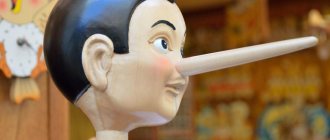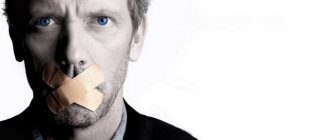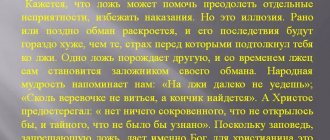Where does a person look when he lies? How can the direction of gaze indicate that a person is lying? These two questions were previously asked by our readers in the comments on the site. The short answer to these questions is “to a certain extent.” It's not as easy as recent TV shows or movies make it out to be. There, a detective is able to determine whether a person is lying simply based on whether he is looking to the right or to the left when he speaks. In fact, it would be foolish to jump to such quick conclusions without further investigation... but a certain technique can achieve something.
So... read, think about it, and test it on your friends and acquaintances to see for yourself how reliable it is.
The look shows the strength of the soul. Paulo Coelho. Alchemist.
Visual Assessment Keys - 'Lying Eyes'
To the best of our knowledge, the first use of the term “Visual Assessment Keys” was by Richard Bandler and John Grinder in their book Frogs into Princes: Neuro Linguistic Programming. Based on their own experience, they found the following: When asked a question, a “normally organized” person (who is not left-handed) directs his gaze in one of six directions, as seen from the perspective of the person looking at him:
Focus on minor details
If a person is lying, then he tries to focus on unimportant details, thereby trying to distract you and miss important ones. Overemphasizing minor details makes the liar feel more comfortable talking to you, but the person hearing the lie will begin to feel like something is wrong and that the other person is clearly missing important information. In this case, it is very easy to catch a liar if you write down the details that he says, and then ask questions related to these details, and thereby check whether he has missed anything.
Extra information
Liars will often try to provide additional information about your question, even if you don't ask them for it. They think that if you make your story more detailed and voluminous, it will seem more believable. But unfortunately for them, the story ends up becoming more confusing and less true. The longer their answer, the more likely it is that it has nothing to do with the truth, or at least partially it.
Read also: Mushroom biome or how to introduce Truffles!
Strengthening words in spoken phrases and counter-questions
Liars often raise their voices and emphasize specific words in the phrases they speak. “I’ve NEVER met this girl in my life!” In this way, liars try to make a person no longer ask new questions by developing a particular topic further. They try to show that they are absolutely pure in front of you, but most often this technique makes the whole story they tell even more implausible. Another common technique of a liar is to counter-question: “Where did you get this information?” or “who told you that?” Thus, the liar is trying to gain time to come up with an answer to your question, while you yourself answer his question.
Where does a person turn his eyes when he lies?
Watch the eye movements of the opponent you are talking to. If a person is trying to remember something (and if he is right-handed), then his gaze will be directed up and to the left. If this person is trying to think of something, then his gaze will be directed up and to the right. It’s the same with left-handed people, only in this case a person will remember the truth by looking up and to the right, and compose lies by looking up and to the left. In addition, people who lie blink or rub their eyes very often. As a rule, liars keep their eyelids closed slightly longer than when blinking normally. Keeping your eyelids closed longer than usual is a sign that the person doesn't like what they're hearing. In addition, a liar may make hand movements at eye level, which may indicate that he wants to “close himself off” from the truth.
Concluding remarks
- A forward gaze or unfocused and non-moving eyes are also considered a sign of visual evaluation.
- Typically, a left-handed person will exhibit the opposite sense of eye direction.
- As with other signs of lying, it is necessary to first find out and understand the basis of a person's behavior before concluding that he is lying based on the direction of his gaze.
Many critics believe that all of the above is just nonsense. However, practice shows that there is something in this. But who's stopping you from finding out for yourself? It is enough to make a list of questions like the ones above and offer them to friends and relatives who will play the role of test subjects. And then watch their eye movements and record the results.
Kvartina Daria Nov 10, 2021
Watch your speech
In addition to body language, it is also worth analyzing the features of speech.
Usually we know well the personal qualities and behavior style of loved ones, so it is not difficult to replace changes in their behavior and speech. But if in front of you is a stranger or an unfamiliar person, you need to work on his basic behavior, as they do in the FBI.
We first calm people down to understand how they behave in normal, minimally stressful situations. Thus, by finding out what their baseline behavior is, we can track changes in behavior regarding a specific issue.
Some people begin to speak faster, their voice may become higher, or they begin to make more mistakes in conversation, forced interjections appear, they begin to cough, etc.
Frightened facial expression
A person who deceives is always afraid of being exposed. Therefore, during a conversation, he may have a slightly frightened expression on his face. But only an experienced psychologist will be able to distinguish it from ordinary embarrassment in front of an unfamiliar person or an unusual situation.
Eyes are not the only indicator of a lie. When analyzing the behavior of your interlocutor, it is worth assessing the full picture: paying attention to gestures, posture and facial expressions. Any information about a person will be useful in order to correctly match the words and the “picture”. Therefore, you should not make hasty conclusions.
Body language and posture
At the beginning of the article we mentioned the children's gesture of covering their mouth with their hands. Of course, adults do not do this, but residual reactions are often observed in them too. For example, light touches to the lips or nose - our subconscious is trying to restrain deceptive speech in this way. A characteristic sign: if a person really has an itchy nose, he will scratch it, but if a person makes this gesture while lying, then he touches his face lightly and abruptly, unreasonably. This is also true for other gestures, for example, when hands are placed near the face to cover a yawn, sneeze or cough. Although, some disguise this gesture with a fake cough.
The ability to gesture correctly while delivering a speech makes it more expressive and helps to hold the attention of the public. At the Benefis theater studio, you will learn to notice other people's nonverbal gestures and consciously control your own. To develop flexibility and mobility of the hands, we use various exercises: “Crocodile”, “Painting the fence”, “Assemble in parts”, “Stroke animals” and other pantomimes. Memorized, mechanical movements have never added persuasiveness to anyone. It’s another matter when certain gestures become a habit and fit organically into the arsenal of expressive means.
Intonation and smile
When the other person is deceiving, his speech and intonation will change. The voice may tremble, and words are spoken more slowly or, conversely, faster. Some people experience hoarseness or high notes slipping through. If the interlocutor is shy, he may start to stutter.
A smile can also reveal insincerity. Many people smile a little when they tell a lie. The interlocutor should be wary if the smile is completely inappropriate. This facial expression allows you to slightly hide awkwardness and excitement. But this does not apply to cheerful people who always try to smile.
Emotions
A person's behavior differs dramatically depending on whether he is telling the truth or lying.
If a lie occurs, then the person’s emotions will be much deeper and more sensual. Any lie implies the presence of a certain mask that a person puts on himself and builds an appropriate line of behavior. Often, the “mask” and other emotions are mixed together. For example, a slight smile is a mask of pleasure, if this feeling is not actually experienced, it is mixed with signs of fear, sadness, disgust or anger. In the case of sincere joy, our gaze will see not only a smile, but also the movement of the muscles located around the eyes.
Bad reaction
. Monitor the other person's emotions as the conversation progresses. If a person is hiding something from you, then emotions may be expressed late, remain on the person’s face for an unusually long time, and then suddenly disappear, appearing before you finish the phrase. This happens because a person thinks intensely about something of his own, poorly maintains the thread of the conversation and demonstrates emotions that he does not actually feel.
Facial expressions that last 5-10 seconds are usually fake. Most genuine emotions only appear on the face for a few seconds. Otherwise they will look like a mockery. For example, surprise that lasts more than 5 seconds in a person is a false emotion. A sincere person's words, gestures and facial expressions are synchronized. If someone shouts: “I’m so tired of you!”, and an angry facial expression appears only after the remark, the anger is most likely fake.
American psychologist Paul Ekman studied people's facial expressions and counted a total of 46 independent facial movements. However, he found that in combination with each other they can convey about 7,000 unique emotions! Interestingly, many of the muscles that move the face are not controlled by consciousness. This means that a fake smile will always, albeit slightly, differ from the real one.
Psychology of lies
A liar always understands that he is getting involved in a risky event. Subconsciously, we perceive lying as a crime. And although there is no criminal or administrative liability for everyday lies, the liar is haunted by the fear of exposure. Even if a person doesn’t give a damn about your opinion about him and your attitude towards him, he will in any case subconsciously do two things:
- Try to block the transmission of false information. This can be clearly seen in children's gestures: a child who is lying tries to cover his mouth with his hands.
- Communicate the liar's fear of discovery. A person begins to assess the consequences of exposure when it is inevitable or has already occurred. Until the lie is exposed, even complete impunity in the future will not relieve a person from the fear of being exposed as a lie.
A liar will try to hide his excitement under a mask of false emotions. But the problem is that anxiety has completely physiological forms in the form of increased heart rate, increased sweating, dry mouth - all this is difficult to hide. Another problem is that it is noticeable to others that the emotions are false. A liar can be revealed:
- eyes
- facial expressions
- voice
- speech
- gestures
Let's take a closer look at each point.
Ability to read eyes
Looking eye to eye, but there is a feeling that the gaze seems to be running. This suggests that the man does not trust his interlocutor or is afraid of her. Fleeting eye contact indicates a man’s complete disinterest in this particular person, or he is still a little worried. Any lack of visual contact indicates indifference to the woman.
When talking, a man looks up, which means the woman annoys him or he has condescending feelings towards her. It’s interesting that if a man looks at the upper right corner, then his memory tries to get some image out of its bins, but if he looks at the upper left corner, then the man tries to imagine something that may not even relate to the subject conversation. Does the man look down and look to the right? This means that he is thinking about everything that his interlocutor just said. And if he looks to the left, then most likely the man is going through something.
It is much more difficult to catch a man lying by looking at him. But you can try. For example, he begins to enthusiastically tell how long he worked and how busy his boss is, how rarely transport runs at this time and how difficult it is to get from work to home, you should listen calmly and ask any question that is not related to the topic. If a man raises his eyes upward and looks to the right corner, then he should be trusted.
#How to hint to a guy about a wedding#
Eye movements
It is true that the eyes are the mirror of the soul. A person is designed in such a way that the eyes actively participate in the process of thinking.
They take position depending on which area of the brain is involved at the moment. Knowing this, we can assume what the brain is doing at one time or another in the dialogue: coming up with something new or processing real information.
| Eyes say a lot. For example, if a person looks up to the left when answering a question, he may be making up a false picture of events. If straight to the left, he selects words for the answer. |
If a person confidently wants to defend his lie and lies deliberately, he tries to maintain eye contact. He looks soulfully into your eyes. This is to know if you believe his lies.
And when a person is taken by surprise and wants to lie so that everyone will forget about it, he immediately switches your attention: he goes into another room, supposedly on business, or starts tying his shoes, sorting out papers and muttering something under his breath...
However, sometimes a person looks into the eyes in the hope of seeing support. He may not lie, but he can be very unsure of his rightness.
Watch for blinking. When they lie, they often blink involuntarily, because for many people lying is still stressful. But, in addition, increased blinking may mean that the subject of conversation is unpleasant to him and causes pain. And the less often a person blinks, the happier he is at that moment.
When asking a question, pay attention to the eye movement at the moment when the person answers. When a person is really trying to remember all the details and tell you, they look to the right. When a person comes up with ideas, his gaze goes to the left.
Usually, when a person remembers (comes up with) something, he looks not just to the side, but down (down right, down left)
See a diagram by neurolinguistic psychologists that tells you what eye movements indicate.
Let's imagine that the picture shows the face of your interlocutor. Further, in order to avoid confusion, we will agree to write in relation to you when you look at the “interlocutor’s face”, and in brackets there will be instructions regarding the face depicted in the diagram
You see that the other person's eyes
- They look to the left and up from you (the person looks to the upper right corner), this indicates the construction of the picture.
- To the right and up from you (for him this is the upper left corner) is an appeal to visual memory.
- Look to the left (right side for the interlocutor) - comes up with a sound,
- to the right (for him the left side) - tries to remember what he heard.
- Eyes below and to the left (lower right corner) - checking sensations and feelings.
- Below and to the right (lower left corner) - reflects on the situation, talks to himself.
- If the gaze is direct , then the person perceives information.
For example, if you asked your boss about the salary date, and while answering, he looked down and to the right relative to you, then he thought about it for the first time and is forming an answer “on the fly”, thinking. And if he just turns to the right, it means he’s saying what he heard before from his superiors. Pay attention to this nuance: if you are talking to a left-handed person, then the left and right sides are mirror opposites. This is also true for right-handers, in whom the left hemisphere still predominates over the right, for example, the so-called. retrained lefties.
There is an opinion that a direct look eye to eye symbolizes the sincerity of a person, but if the eyes are averted, then they say that someone is “hiding” his eyes and hiding something. In reality, this is not the case. During a conversation, it is often necessary to break eye contact in order to focus on a thought, think, or remember. Based on materials from bskltd.ru, mirsovetov.ru
Interesting fact:
Scientists from the State University of New York at Buffalo have developed a high-tech polygraph. Based on eye movements, it recognizes when a person is telling the truth and when he is lying. According to the researchers, their system is able to detect false statements with an accuracy of more than 80%.
The new system was tested on volunteers. Before the experiment began, they were asked to guess whether they had stolen a check that was made out to a political party they did not support. An interrogator sat next to the subjects, who first asked questions that were not related to the topic, and then directly asked about “theft.”
At this time, the program, using web cameras, monitored the violation of the trajectory of eye movement, the speed of blinking and the frequency with which the participants in the experiment shifted their gaze. As a result, the system was able to successfully detect lies in 82.2% of cases, while for experienced investigators this rate was about 60%.
How to recognize a lie by facial expressions and gestures:
***
By the way, there is also a category of people who believe in their words so sincerely that they infect other people with their conviction. In a word, such people are born actors.
It should be noted that just as in nature there are no two identical personalities, each person is individual in his own way, so there is no universal set of signals that detect lies. Therefore, all signs must be carefully analyzed in the context of the current situation, and pay attention to both the voice and emotions, and do not forget about body movements. The tongue can lie, but the body cannot lie.
However, be careful and do not make hasty conclusions, no matter how insightful people you are, because even Sherlock Holmes once suspected a girl of a terrible crime, mistaking her awkward gesture for an attempt to hide the truth. Later it turned out that the girl was simply embarrassed about her unpowdered nose :o).
And what do you think,
Is it possible to determine a person's mood by their eyes?
What can moles tell you?
How to recognize a lie by the eyes?
1) Psychologists have long noticed that a person who lies, as a rule, takes his eyes away from his interlocutor to the left, and then lowers them down. So he tries to find the right words or invent images to lie.
If you notice such behavior in your interlocutor, there is reason to believe that he is insincere with you. But it is not yet an established fact that he is outright lying to you. We need to continue monitoring his behavior.
2) If during a conversation a person raises his eyes upward, it means that he is trying to isolate and describe images from visual or visual memory. If he turns his head to the right or left side, it means he is working with auditory or auditory memory.
If your interlocutor lowers his head down, it means that he wants to concentrate and carefully controls everything that is said. Watch him carefully, it is at this moment that he may begin to invent and voice lies.
3) It is important to record the interlocutor’s first reaction to the question asked to him. If at the same time he begins to roll his eyes up and to the right or lowers them down and to the left, it means that he is panickingly trying to come up with some acceptable false legend.
It should be remembered that a professional liar, i.e. A person who lies constantly, is skilled in this matter, and also has good acting skills, is very difficult to catch in a lie by looking at his eyes.
4) If you have repeatedly encountered the fact that a particular interlocutor is lying to you, then try to remember how he behaves in this case. This will help you catch him in a lie in the future.
You should remember the entire strategy of his behavior: how he “runs” his eyes, what phrases he pronounces, which direction he looks, how he behaves in general. This information will help you in the future to avoid becoming a victim of a liar.
Body
First of all, you should pay attention to the posture of the interlocutor
“Closed poses” - crossed arms and legs - are well known. They say, at a minimum, that the interlocutor is not very inclined to communicate with you. A person may look relaxed, but attempts to hide his hands, fold them on his chest or lock them on his knees give him away. It’s not a fact that he’s lying to you, but he clearly wants to hide something from you, not to let it slip.
It happens that a liar shrinks, as if he is trying to take up as little space as possible.
Another pose: if a person takes a step back during a conversation, most likely he himself does not believe what he is telling you.
There are “slips in gestures”, a kind of non-verbal leaks of information. Not every liar makes them, but if they happen, it is a reliable sign of his intentions.
If a person touches his face with his hands: scratches his nose, covers his mouth, then these are signs that he is subconsciously closing himself off from you, putting a barrier between you.
The most common gestures of deception:
[/td]
| An involuntary shrug of the shoulders indicates indifference, that the person doesn’t care. And if he twitches one shoulder, it means that he is lying with a very high degree of probability. |
| Rubbing the eyes. When a child does not want to look at something, he covers his eyes with his palms. In an adult, this gesture transforms into rubbing the eye. In this way, the brain tries to block something unpleasant for us (deception, doubt or an unpleasant sight). For men, this is a more pronounced gesture - they rub their eyes, as if a speck has gotten into their eye. For women, this gesture is less noticeable and may well pass for correcting makeup, since ladies usually gently rub their lower eyelid with a finger. But even here you should be careful - suddenly a speck or an eyelash actually got in! |
| Touching the nose (often with a quick, subtle movement) can also be a sign of lying. This gesture is called the “Pinocchio symptom.” Remember the story about Pinocchio, where his nose began to grow rapidly when he lied? In fact, physically this process actually occurs - special substances catelochamines are released in the body, which lead to irritation of the nasal mucosa, pressure also increases, blood flow increases and the nose actually enlarges a little. But this is not noticeable, but it is noticeable how your interlocutor begins to reach for his nose and scratch it. |
| Covering your mouth with your hand or coughing into your fist, according to psychologists, shows a desire to suppress the utterance of your own false words, to prevent them from escaping. |
| Brushing imaginary fluff from clothes . The interlocutor does not approve of what he heard. He doesn't want (or can't) say it out loud, but the gesture betrays his thoughts. |
| Pulling the collar. It's a familiar gesture, isn't it? It’s as if it’s getting stuffy and it’s hard for a person to breathe. Deception leads to increased blood pressure and increased sweating, especially if the deceiver is afraid of being caught in a lie. |
Other deceptive gestures include:
Rubbing your earlobe. Let's get back to our monkeys! This is a “I don’t hear anything” gesture. It is usually accompanied by a glance to the side. Variants of this gesture: rubbing the earlobe, scratching the neck behind the ear, picking (sorry) in the ear or twisting it into a tube. Scratching the neck. Typically, people do this with the index finger of the hand they are writing with. The average person scratches their neck 5 times a day. This gesture means doubt. That is, if a person tells you something like “Yes, yes! I completely agree with you” and at the same time reaches out to scratch his neck, this means that in fact he does not agree and doubts.
Fingers in mouth. The most striking character with a finger in his mouth is Dr. Evil from the film about Austin Powers. He almost always keeps his little finger near his mouth. This is an unconscious attempt by a person to return to a state of security that is usually associated with infancy and sucking on the same pacifier. An adult sucks a cigar, a pipe, glasses, a pen, or chews gum. Most touching of the mouth is associated with deception, but it also indicates that the person needs approval. Perhaps he is lying because he is afraid that you will not like the truth.
Pay attention to such a gesture as the extended middle finger . It can simply lie on the knee, or the person accidentally touches his face with it. This is a gesture of hostility and hidden aggression: the interlocutor seems to send you to hell.
You should also notice if the interlocutor shifts from foot to foot or even takes a small step back. This indicates a desire to leave, to distance themselves from you, so as not to give something away. It is especially important to pay attention to backward movements when asking questions. If the respondent’s head suddenly moves back or down , this may also be an attempt to close himself off.
Kinesthetic memories
Memories relating to tactile and olfactory sensations are called kinesthetic. Fishing out such memories from his memory, a person looks down and to the left . For example, you can ask your interlocutor: “Do you remember how the pies your mother cooks smell?” He will involuntarily look down and to the left. But if your daughter, for example, told a story about how she and her friend were choosing perfume and therefore was late for a meeting with you, ask what scent they ended up buying the perfume with. If her gaze drops to the right for a moment, it means that she did not remember, but came up with an answer.
Facial muscle tension
If you look at your opponent very carefully, you can figure out whether he is cheating or not. It will be revealed by micro-tension of the facial muscles, which lasts for several seconds. No matter how “stony” the interlocutor speaks, instant tension is still inevitable.
The deceiver is revealed not only by the position of the eyes when lying, but also by uncontrolled involuntary movements of the skin and other parts of the face. The most common include: quivering lips, rapid blinking, or changes in skin color.
Let's start with the pupils. (Look into my eyes and you will see the truth)
The pupils dilate or contract in certain lighting conditions. It all depends on the mood and brightness of the lighting. If a person is emotionally excited, then his pupils become slightly more dilated than in the same lighting, in a calm state. The same thing happens when a person looks at something he likes. It’s not for nothing that they say “the eyes lit up.” A person with dilated pupils looks the most attractive and mesmerizing. But if the pupils narrow, then aggression, anger and irritation increase in the person.
Behavior during provocations
Increased breathing, heaving of the chest, frequent swallowing, protruding perspiration - these are signs of strong feelings. It is possible that they are lying to you. Blushing is a sign of embarrassment, but you can also become embarrassed from shame for lying.
Do you like field hockey?
If you try to abruptly change the subject, the person telling the lie will take it with relief and support your initiative, because he understands that the less you talk to him, the less chance he has of “messing up” and giving himself away.
If the interlocutor is sincere, then his natural reaction will be a misunderstanding of the reason for the change of topic, dissatisfaction that his story was not heard to the end. He will try to return to the topic of conversation. I don’t like you guys...
If you have doubts about the veracity of the interlocutor’s words, MirSovetov advises to implicitly show that you do not believe the interlocutor’s story: after his answer to the next question, pause, look closely, with distrust. If they are not honest with you, it will cause embarrassment and uncertainty. If a person tells the truth, then he often begins to get irritated and stare at you. The following changes can be noted in it: embarrassment disappears, lips compress, eyebrows frown.
Looking at the floor or straight into the eyes
© If a person is lying, as a rule, he avoids making eye contact so as not to give himself away. However, some liars, on the contrary, try to make eye contact with their interlocutor as often as possible. A direct “eye to eye” look always gives credibility to the story, which is successfully used by many sophisticated and experienced deceivers. If during a conversation you cannot catch the eye of your interlocutor, and then he himself begins to look intently and persistently into the eyes, you should not believe the words of this hypocrite.
Voice and speech
The teachers at the Benefis school know many tricks on how to spot a liar. His voice and speech often give him away. A person who tells a lie tries to pronounce words faster so as not to give himself away. It is easier to rehearse a lie in the form of a monologue or a legend, but it is almost impossible to prepare for a dialogue: after all, we do not know what questions the interlocutor may ask.
It is questions that usually confuse liars: they make them hesitate, mumble, get confused in their testimony and say unnecessary things. Therefore, during interrogations of experienced police officers, it is alarming when two or more suspects tell almost verbatim the same story, rehearsed to the smallest detail.
Anyone who has had to attend interrogations as an interrogated person will long remember the feeling of dryness in the throat. It arises from strong excitement and greatly interferes with speaking.
The liar tries with all his might not to give himself away. Excessive efforts are noticeable, for example, an obsessive desire to emphasize the veracity of one’s words, even if no one questions this veracity. He uses characteristic speech patterns: “I swear”, “on my word of honor”, “I bet”, “I wish I could fail in this place.” At the same time, the liar’s voice betrays his excitement and attempt to appear honest. The voice becomes louder, the tone is slightly higher than usual. Often the liar himself notices that his words sounded false, and begins to worry even more: he stumbles, hesitates, stammers, says unnecessary words, which further aggravates his predicament.
Controlling speech is as difficult as controlling your own emotions. The information above alone is not enough to learn how to speak persuasively. You need to constantly train, preferably under the guidance of an experienced teacher. There are many theatrical methods of voice production that the teachers of the Benefit Studio use in their classes:
Voice training exercises make speech clearer, louder, more measured, in other words, more convincing.
Hand Gestures:
- Open palms - honesty, frankness;
- The palm turned upward is a asking gesture; with this position it is easiest to achieve the request, since it does not demonstrate pressure from the one asking;
- Palm turned down (looking at the floor) - authority. On the part of the one who uses such a position, psychological pressure is felt;
- Hands clenched into fists - an aggressive state, a desire to sometimes even commit an act of physical violence against a dialogue partner.
- The thumb is hidden inside - fear or fear of doing something that will cause critical assessment.
Tell me everything first
Ask the liar to repeat his entire story from the beginning. If the story is fictitious, then it will be very difficult for a person to remember all the details that were present in it. You will immediately notice that the person will feel uncomfortable and agitated and will begin to fumble for words.
In most cases, it is very easy to tell when a person is lying to you. Simply because you literally feel it, and also know that this person cannot tell the whole truth one hundred percent. If you begin to more closely observe a person's behavior and movement during a conversation, you will begin to notice much more detail. Initially, you will most likely attribute everything to your “gut”, but you will soon realize that you have become more observant than you previously thought. By following these basic principles, you will not only be able to catch liars with ease, but you will also become more attentive and observant of the people you talk to.
Micromimicry
The most honest emotions tend to appear on a person's face for short moments only at the very beginning of a conversation. This could be a half-smile that lasts the first five seconds, or an excited look that lasts about the same amount of time. These microexpressions of emotions are sometimes noticed literally on a subconscious level and allow you to correctly determine whether a person is lying or not. Although you may not even understand how you found out. Many people literally feel in their gut that the person sitting opposite them is lying. Usually this conclusion can be reached by observing microexpressions. As a rule, such expressions of emotions happen very quickly, but if you are attentive, you will definitely be able to notice them.










